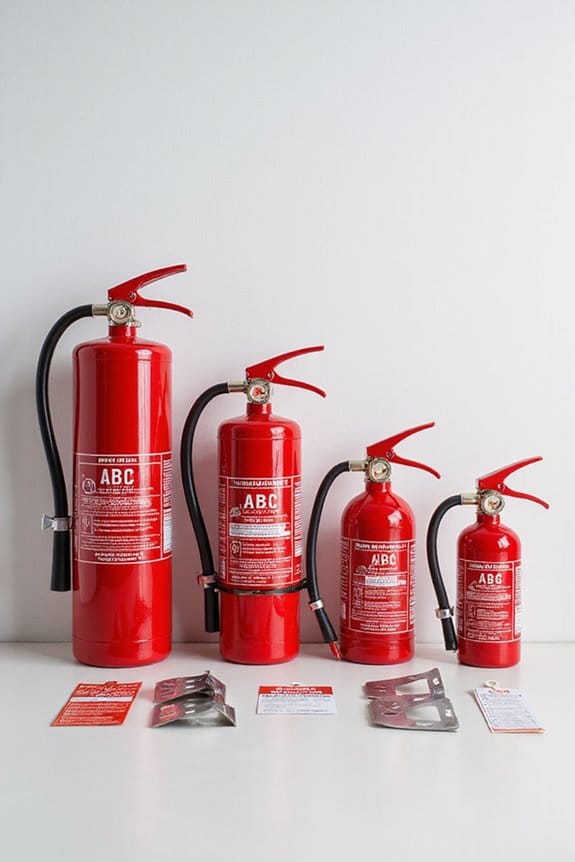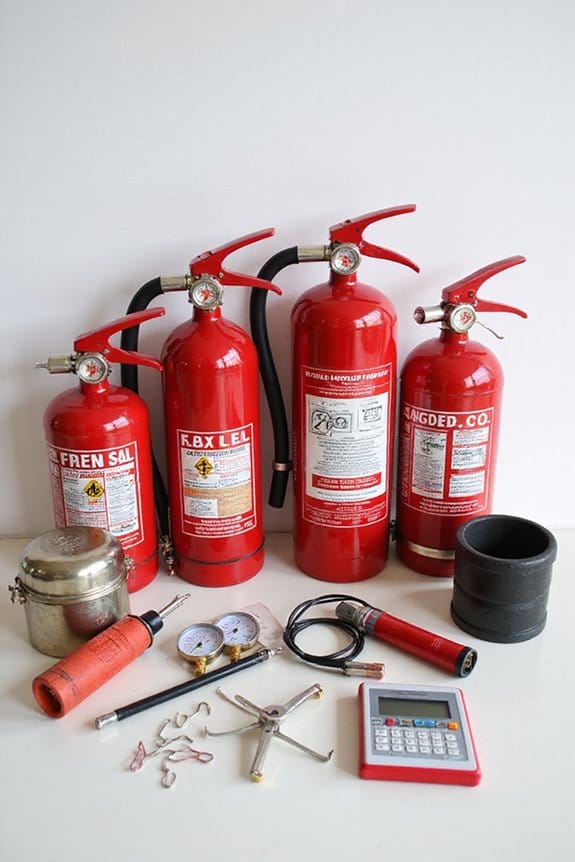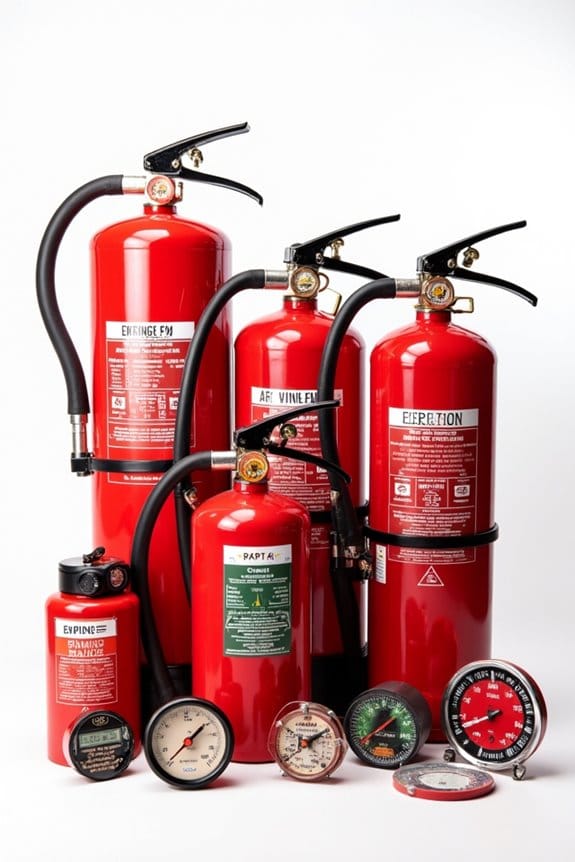When it comes to fire extinguishers for your home, I recommend sizes between 5 and 10 pounds. A 5-pound extinguisher’s perfect for most areas, but if you’re in high-risk spots like kitchens or garages, go for something heavier. Make sure to have a multi-purpose model; they tackle various fire types. Don’t worry, I’ll share more details about placement, ratings, and maintenance, so you’ll be well-prepared for any fire safety situation!
Key Takeaways
- Recommended fire extinguisher sizes for home use range from 5 to 10 pounds for effective handling.
- A 5-pound extinguisher is suitable for most areas, while heavier options are ideal for high-risk zones.
- Multi-purpose extinguishers (e.g., 2-A:10-B:C) can address various common home fire risks.
- It’s essential to have at least one extinguisher with a minimum 2-A rating on each floor.
- Ensure extinguishers are easily accessible, mounted between 3.5 to 5 feet high, and within 30 feet of kitchens.
Recommended Fire Extinguisher Sizes for Home Use
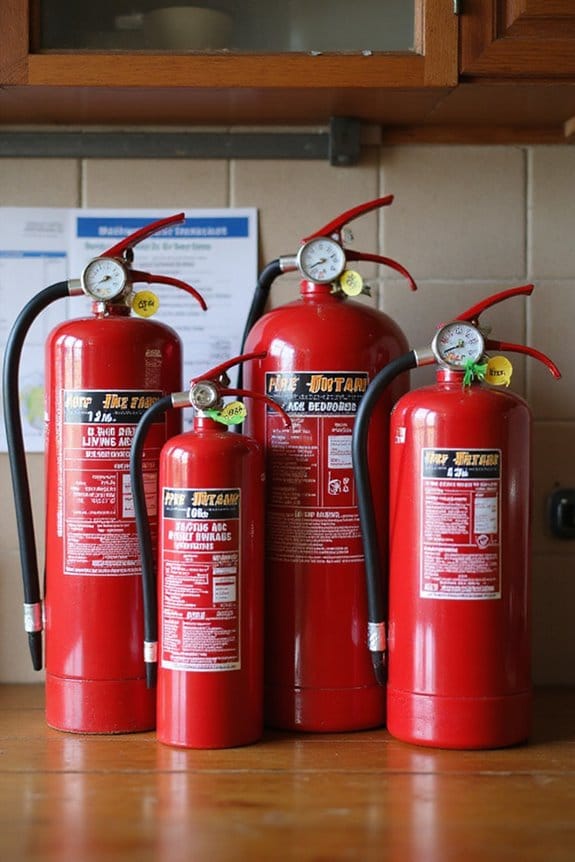
When it comes to choosing the right fire extinguisher for your home, I’d recommend focusing on sizes between 5 and 10 pounds. Here’s why:
- Optimal Weight: Extinguishers in this range strike a balance between effectiveness and ease of use. A 5-pound extinguisher is great for most areas, but you might want something heavier for high-risk spots like kitchens and garages.
- Effective Fire Class Coverage: Multi-purpose fire extinguisher types in this weight range can tackle most common home fires, including those involving ordinary combustibles and flammable liquids.
- Quick Response: The lighter weight means you can grab it quickly in an emergency, which is essential!
Placement and Coverage Guidelines
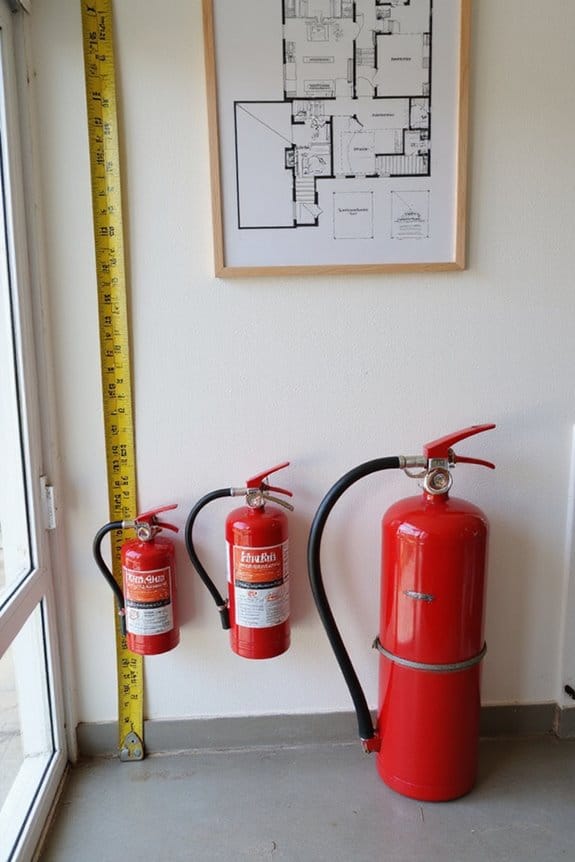
Choosing the right fire extinguisher size is just the beginning; proper placement is just as important. Here are some fire extinguisher placement tips to keep in mind:
- Mounting Height: Place extinguishers between 3.5 to 5 feet for easy access. Keep heavier ones lower.
- High-Risk Areas: Install extinguishers within 30 feet of kitchens and near exits, guaranteeing quick access during emergencies.
- Coverage Strategies: Have extinguishers on every floor, including basements and attics. This minimizes travel distance, ideally no more than 30-40 feet.
- Clear Paths: Confirm your paths to extinguishers are clutter-free; no one wants to trip while saving the day!
Fire Extinguisher Ratings and Class Considerations
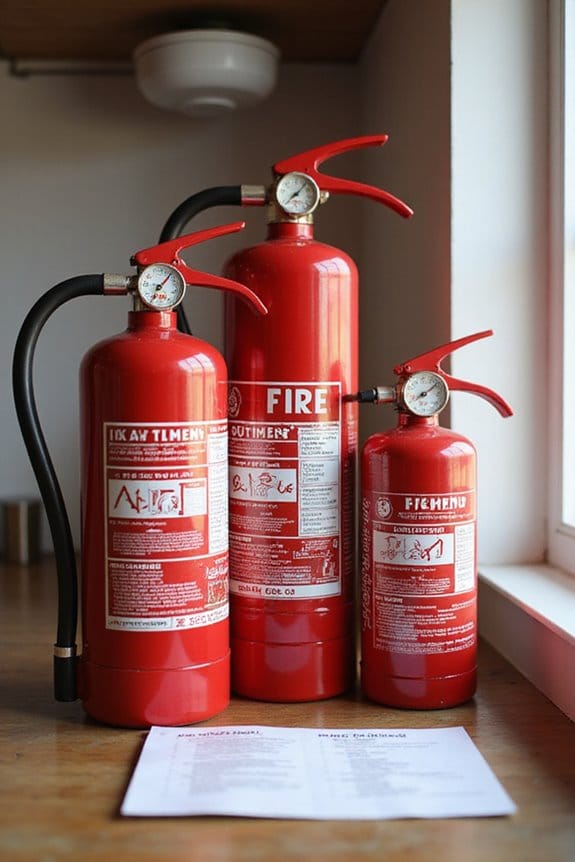
Understanding fire extinguisher ratings and classifications is essential for keeping your home safe from potential fire hazards. Here’s what I’ve learned about fire extinguisher types:
- Class A: For ordinary combustibles like wood and paper.
- Class B: Handles flammable liquids such as gasoline and oil.
- Class C: Safe for electrical fires, using non-conductive agents.
- Class D: Targets combustible metals, but not common in homes.
Numerical ratings tell you how effective these extinguishers are. For instance, a 2-A rating means it’s twice as effective as a 1-A. During fire safety training, I found that multi-purpose extinguishers (like 2-A:10-B:C) are lifesavers for covering various risks. So, don’t skimp on these ratings—they’re vital for your safety!
Regulatory and Code Recommendations
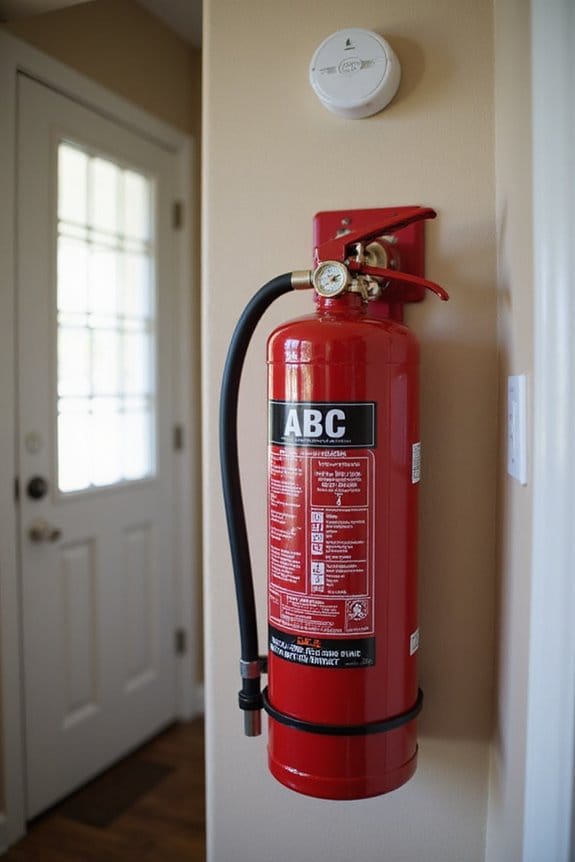
Regulatory recommendations for fire extinguishers in homes are more than just guidelines; they’re essential for your safety. First, you need at least one operable extinguisher with a minimum 2-A rating on each floor, plus a 2A-10BC rated extinguisher in the kitchen.
Here’s a quick checklist for regulatory compliance:
- Installation: Mount extinguishers no higher than 5 feet and within 10 feet of kitchens.
- Annual Inspection: Have a certified contractor check them yearly.
- Documentation: Keep records of inspections handy—trust me, it helps during audits!
Size Impact on Usability and Effectiveness
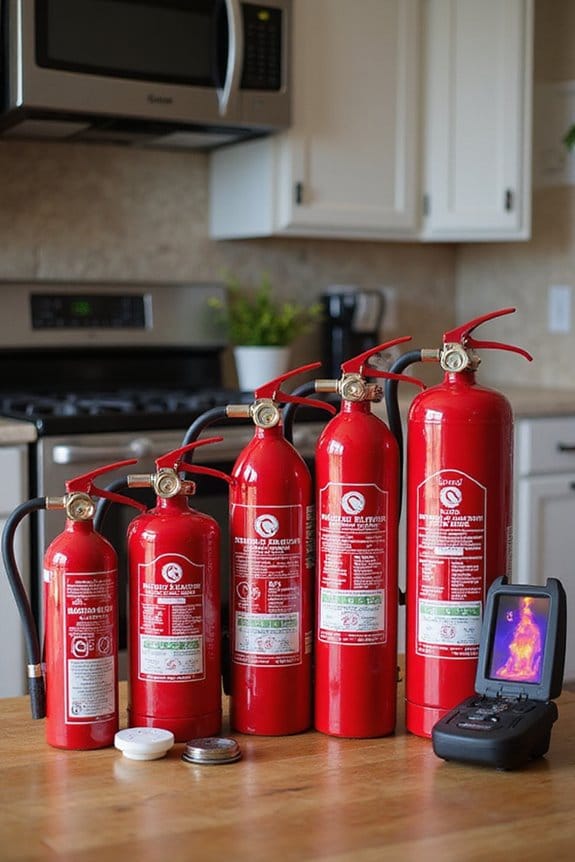
When it comes to fire extinguishers, size really does matter—especially in a home setting. Here’s why:
- User-Friendly Design: Smaller extinguishers, around 5 lbs, are easier to handle, making them ideal for quick responses. Trust me, in a panic, you want something manageable!
- Ergonomic Handling: A comfortable weight encourages you to act quickly. Oversized units can be intimidating, leaving you frozen instead of fighting the fire.
- Effectiveness: The right size guarantees you have enough extinguishing agent for the fire class you might face. A 5-lb extinguisher is great for average rooms, while larger ones are better for bigger risks.
Fire Extinguisher Maintenance and Accessibility
Keeping your fire extinguisher in top shape is essential for guaranteeing safety at home. Here’s how to stay on top of fire extinguisher inspections and accessibility challenges:
- Monthly Checks: Inspect for damage, verify the pressure gauge, and guarantee the nozzle is free of debris.
- Annual Maintenance: Hire a certified professional to test the internal mechanisms and recharge if necessary.
- Accessibility: Mount extinguishers in easy-to-reach spots, away from furniture and locked cabinets.
- Cleaning: Wipe down your extinguisher regularly to keep it clean and visible.
Choosing the Right Extinguisher for Different Areas
Have you ever wondered how to choose the right fire extinguisher for different areas in your home? It’s essential to match extinguisher types to specific fire risks. Here’s a quick guide:
- Kitchen: Use a 5-pound Class K extinguisher or an ABC extinguisher (4A:80B:C rating) for grease fires.
- Living Areas & Bedrooms: A 5 or 10-pound ABC extinguisher is ideal for general fires involving paper and electrical hazards.
- Garage & Workshop: Opt for a 10-pound ABC or Class B extinguisher, as these areas have flammable liquids.
Tips for Educating Family Members on Fire Safety
Educating your family about fire safety can feel a bit intimidating, but it doesn’t have to be! Here are some tips to help you get started:
- Create a Fire Escape Plan: Involve everyone in developing and practicing a plan tailored to your home’s layout.
- Recognize Alarms: Teach family members to identify smoke alarm sounds and evacuate immediately.
- Discuss Common Hazards: Talk about cooking dangers and other fire risks to promote prevention.
- Use Educational Resources: Utilize pictorial instructions and online graphics to suit all literacy levels.
- Hold Regular Drills: Schedule family fire drills to reinforce preparedness and keep everyone aware.
Additionally, remind family members about the importance of regular testing of alarms to ensure they function properly in case of an emergency.
With family involvement, these steps can make fire safety a natural part of your household routine!
Frequently Asked Questions
How Often Should I Replace My Fire Extinguisher?
I check my fire extinguisher maintenance every month, looking for expiration indicators. Typically, I replace it every 12 years, but if I see damage or pressure loss, I know it’s time for a new one.
Can I Use a Fire Extinguisher on Electrical Fires?
When facing electrical fires, I’ve learned that using the right extinguisher types is essential. Class C extinguishers are designed for such risks, ensuring safety while effectively combating those dangerous situations without conducting electricity.
What Should I Do if My Extinguisher Is Expired?
If my extinguisher’s expired, I won’t use it. I’ll check for damage and replace it if necessary. Regular extinguisher maintenance is essential for fire safety, so I always stay proactive about inspections and replacements.
Are There Fire Extinguishers Specifically for Kitchens?
Picture flames flickering near my stovetop—kitchen safety is essential. Yes, there are fire extinguishers specifically designed for kitchens, ensuring effective fire prevention against grease and electrical fires, keeping my cooking space secure and ready.
How Do I Check if My Extinguisher Is Functional?
To check if my fire extinguisher’s functional, I perform a safety inspection monthly. I guarantee it’s visible, check the gauge, and look for damage. Regular fire extinguisher maintenance keeps it ready for emergencies.

